해외 기업을 위한 일본 웹 사이트 디자인 및 UI/UX 탐색

Entering the Japanese digital market requires more than just translation—it demands a deep understanding of cultural expectations and user behavior. For international companies, Japanese website design and UI/UX present a unique blend of high information density, visual vibrancy, and values rooted in hospitality and thoroughness. What may seem cluttered or overly complex to Western audiences is often perceived in Japan as trustworthy, detailed, and considerate.
This guide demystifies the core principles behind Japanese digital aesthetics and user experience, helping global brands adapt their online presence for authentic connection and lasting impact. Whether you're launching a new product or localizing a website, aligning with Japanese expectations is crucial for building trust and ensuring success in one of the world’s most nuanced digital markets.
Japanese Website Design and UI/UX: A Comprehensive Guide
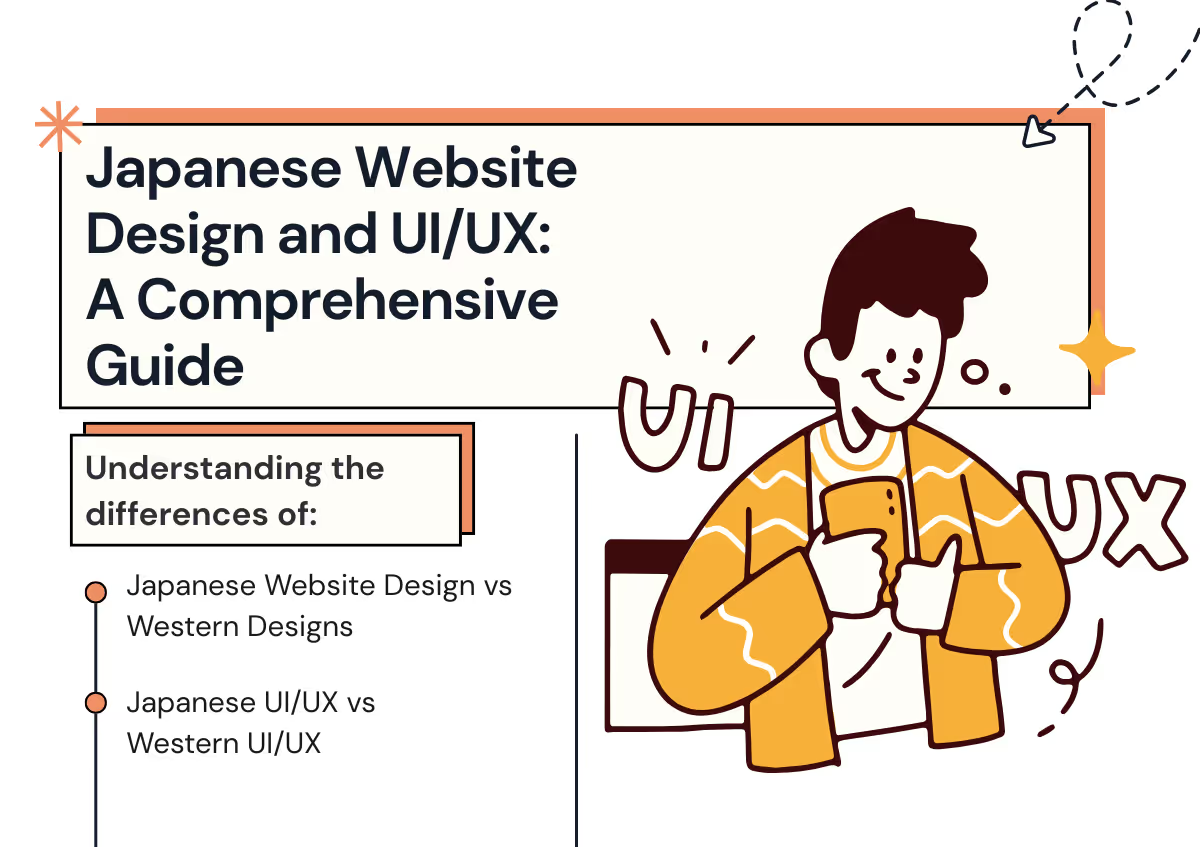
Japan’s digital landscape presents a fascinating mix of tradition, cultural nuance, and evolving technology that sets its website design and UI/UX apart from Western approaches. For international companies aiming to enter or succeed in the Japanese market, understanding these differences is essential—not just in how websites look, but also in how users interact with them and what they expect from the experience.
While website design in Japan often appears more complex, dense, and information-rich compared to the minimalist trends popular in the West, this is not seen as negative. In fact, Japanese users tend to associate detailed layouts with trustworthiness and thorough service. Similarly, Japanese UI/UX practices reflect deep-rooted cultural values such as hospitality (Omotenashi), continuous improvement (Kaizen), and careful consideration for others (配慮).
We will explore:
- The key differences between Japanese and Western website design—focusing on visual style, layout, and structure.
- The distinct approaches to UI/UX—how users interact with websites, what makes them feel comfortable, and how design choices support their needs.
In the following sections, we will break down these differences and offer practical insights into how global brands can thoughtfully adapt their digital strategies to align with Japanese expectations.
Differences Between Japanese Website Design and Western Designs
Japanese website design and Western website design differ in ways that go beyond mere aesthetics—they reflect distinct cultural mindsets and communication styles.
One of the most striking differences lies in information density. Japanese websites often appear visually busy, with dense text, banners, sidebars, and multiple call-to-actions all present on a single page. This design approach is rooted in the Japanese preference for providing as much information as possible upfront. In Japan, complexity is not viewed negatively; instead, it can signal thoroughness, trustworthiness, and attentiveness to user needs.
By contrast, Western websites generally favor minimalism—clean layouts, larger whitespace, and a focus on a single key message per page. This reflects the Western design principle of “less is more,” where simplicity is associated with clarity and elegance.
Additionally, Japanese websites frequently use bright colors, animated banners, mascots, and characters to create warmth and familiarity. Many sites include multiple navigation menus, sometimes stacked in sidebars or at the top and bottom of the page, offering users a variety of pathways to information. This mirrors Japan’s cultural emphasis on offering choices and avoiding forceful persuasion.
In comparison, Western web design typically opts for fewer navigation options and streamlined user journeys, reducing cognitive load and keeping users focused on conversion goals. Typography also differs: Japanese websites often use multiple font styles, sizes, and colors to create visual hierarchy, whereas Western designs maintain consistency and restraint in typographic choices.
Differences Between Japanese UI/UX and Western UI/UX
The differences in UI/UX between Japanese and Western digital experiences are equally significant and often more subtle, rooted in deeply held cultural values.
In Japan, users tend to feel more comfortable when:
- They are presented with multiple options rather than being funneled into one “best choice.” This reflects Japanese communication styles, which favor indirectness and respect for personal choice.
- A website shows detailed information and explanations—from product specs to company policies—allowing users to research thoroughly before taking action. This ties back to the cultural value of 慎重 (careful decision-making).
- Friendly, supportive elements such as mascots, chatbots, or illustrated guides are used to assist and comfort the user. This reflects Japan’s deep-rooted concepts of Omotenashi (hospitality) and the use of kawaii (cute) design to humanize digital experiences.
Western UI/UX, by contrast, tends to prioritize:
- Efficiency and speed: guiding users quickly toward a goal with fewer steps and choices.
- Emotional appeal through minimalism and storytelling rather than exhaustive information.
- A greater focus on user autonomy through less hand-holding and more intuitive design patterns.
For instance, while a Japanese e-commerce site may offer extensive FAQs, reviews, and multiple purchase options on a single page, a Western site would likely simplify this to a clear “Buy Now” path with optional deeper content placed further down or on separate pages.
Moreover, in Japan, users often expect websites to maintain a degree of formality and politeness in language, even on digital platforms—this is less common in Western UI/UX, which tends to adopt more casual, conversational tones.
Finally, while both cultures increasingly embrace mobile-first design, Japanese users still place high importance on detailed navigation menus and clear trust signals (e.g., certifications, guarantees) even on mobile screens—details that Western minimalism often omits.
Key Features of Japanese Websites

While minimalism is a valued aspect of Japanese aesthetics, evident from serene gardens to Muji and Uniqlo's simple designs, Japanese website design and UI/UX often tell a different story. They reflect a culture that values thoroughness, hospitality, and attention to detail. For international companies, understanding both the visual design differences and user experience expectations is crucial for successfully localizing a digital presence in Japan.
Below, we explore the distinct features of Japanese website design and the unique tendencies in UI/UX, while comparing them with Western standards to help you tailor your approach effectively.
Information Density and Space Utilization: Japanese Website Design vs. Western Website Design
Japanese Website Design:
A defining characteristic of Japanese websites is their dense, information-rich layouts. Pages are often filled with detailed content, multiple sidebars, banners, and layered navigation menus—all within a single screen. This approach reflects Japan’s cultural emphasis on thoroughness, efficiency, and hospitality (Omotenashi), where providing all relevant information upfront builds trust and reduces uncertainty for users.
Rather than using white space to create visual breathing room, Japanese websites tend to maximize space by stacking content vertically and horizontally. This mirrors not only the crowded, compact nature of Japan’s urban spaces but also the cultural preference for choice and self-guided decision-making.

The Rakuten Japan homepage offers multiple product categories, time-sensitive deals, and a wide array of links, ensuring users can find whatever they need without excessive navigation.

Kinokuniya Japan features densely packed book categories, promotions, and recommendations on its main page.
Western Website Design:
In contrast, Western websites prioritize minimalism, clarity, and simplicity. The focus is on presenting one core message or action per page, using larger images, fewer words, and clear call-to-actions. White space is used deliberately to create a sense of ease and focus.
The typical Western user journey is linear and guided—users are encouraged to follow a streamlined path without being distracted by too many simultaneous options.

Rakuten France or limit the amount of information on the screen, using clean layouts and visual hierarchy to gently guide the user.
User Expectations and Experience: Japanese UI/UX vs. Western UI/UX

Japanese UI/UX:
- Japanese users often feel more comfortable with multiple choices and detailed explanations. A site that offers too few options can feel incomplete or untrustworthy.
- Banners, pop-ups, and character mascots are frequently used to create a friendly, welcoming environment that embodies Omotenashi—the spirit of hospitality.
- There’s a strong cultural expectation for depth over speed; users prefer to have the ability to research thoroughly before taking action.
Example: Yahoo! Japan and Nissen Japan use multiple navigation layers and animated mascots to engage users.
Western UI/UX:
- Western UX focuses on efficiency, speed, and simplicity. Too many choices or too much information can overwhelm users, leading to higher bounce rates.
- Emotional appeal is often conveyed through visual storytelling and minimalist copywriting rather than comprehensive technical details.
- Users are often encouraged to take quick action through short, persuasive copy and clear CTAs.
Example: Apple.com (US) guides users with simple messaging and minimal distractions.
Image Optimization and Visual Balance
Japanese Website Design:
In Japanese websites, images are used functionally rather than emotionally. Rather than dominating the screen with large visuals, Japanese websites tend to use smaller, carefully optimized images that serve as navigational aids or as visual breaks between text-heavy sections. This strategy ensures that users can still access dense information without feeling overwhelmed.
This approach reflects two key cultural values:
- Efficiency and practicality: Images are there to support information, not replace it.
- Consideration for speed and accessibility: Since many Japanese users access sites via mobile (with varying internet speeds), keeping image sizes small and optimized is crucial.
Japanese UI/UX emphasizes maintaining high engagement through balance—images, icons, and banners are used to break monotony, but the primary goal is to keep information accessible and organized. Additionally, Japanese websites often favor character mascots, illustrated icons, or playful visuals—even on corporate or government sites—as a way to humanize the interface and create a sense of friendliness.
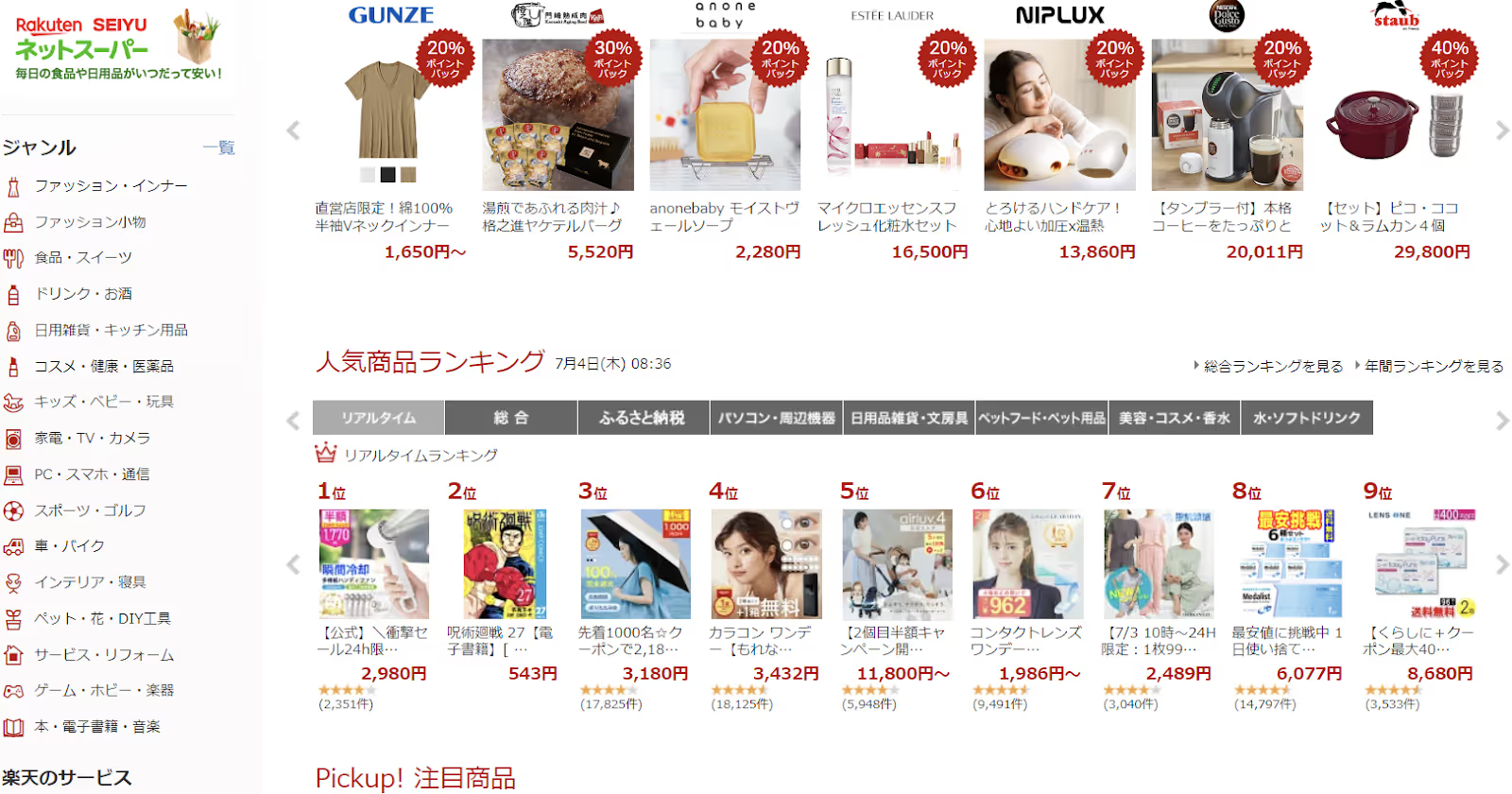
Here on Rakuten Japan, images are small yet plentiful—product thumbnails, promotional banners, and navigation icons coexist on the same page to keep users visually engaged without slowing down performance.
Western Website Design:
In Western markets, images are often the centerpiece of the design, serving to create an emotional connection or to tell a brand story. Large, high-quality, high-impact visuals dominate landing pages—often with minimal accompanying text.
Western UI/UX leans toward simplicity in content but richness in visuals. The focus is often on creating an aspirational feeling—for example, lifestyle images in fashion, immersive product photography in tech, or emotional brand messaging.
Additionally, Western websites often use images to set the tone or mood of the site, rather than to convey granular information. There’s a heavier reliance on hero images, full-width banners, and cinematic content.
For example, sites like Zara (US) or Nike.com lead with large-scale, high-resolution imagery, often with very few words, placing emotional appeal at the forefront of the user journey.
When localizing, companies should resist the urge to “downsize” Western visuals completely, but should adapt by breaking up images into smaller components and placing them alongside detailed content in the Japanese context.
Color Usage: Vibrancy in Japan vs. Restraint in Western Design
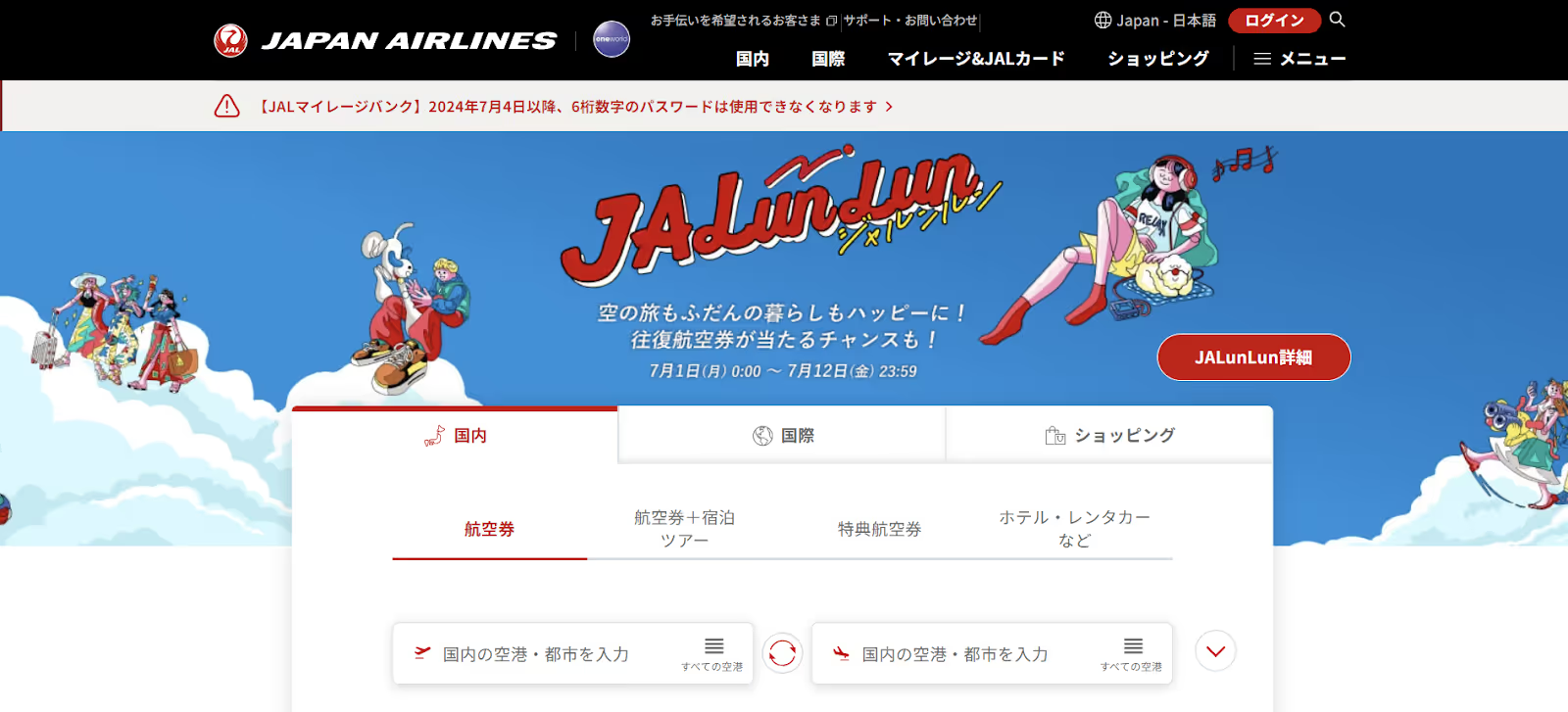
Source: Japan Airlines’ homepage for Japanese-speaking customers

Source: Japan Airlines’ homepage for English-speaking customers
Japanese Website Design:
In Japan, color plays an active, dynamic role in grabbing attention, organizing content, and communicating emotion. Japanese websites frequently use bright, high-contrast colors—especially reds, yellows, blues, and greens—to highlight promotions, limited-time offers, and important sections. It is not uncommon to see multiple color highlights on the same page.
This vivid use of color reflects cultural tendencies toward visual excitement and engagement—especially in retail, entertainment, and e-commerce. The choice of color can also reflect seasonal changes, festivals, or regional preferences, creating a website that feels alive and responsive.
In Japanese UI/UX:
- Red might signal urgency (limited-time sale).
- Pink might convey friendliness or cuteness (kawaii).
- Blue might express trust or calmness.
Additionally, colors are sometimes paired with mascots or animated visuals to create an environment that is not just functional but also emotionally welcoming, reflecting Japan’s strong service culture (Omotenashi).
In the pictures above, Japan Airlines (JAL Japan) uses brighter colors, festive visuals, and friendly layouts on its domestic site to appeal to local travelers, especially around seasonal campaigns or travel holidays.
Western Website Design:
In contrast, Western websites typically use muted, restrained color palettes that align with brand identity and create a sense of sophistication and calm. Colors tend to be consistent across the site, with minimal use of bright or contrasting shades.
In Western UI/UX:
- Colors are typically used sparingly to highlight CTAs or key areas, often in soft or neutral shades.
- There’s a strong emphasis on brand consistency and emotional tone over seasonal shifts.
Additionally, many Western websites avoid multiple bold colors in one view to maintain a clean, uncluttered feel.
As an example, the JAL global website (English version) uses a much softer color palette, minimal accents, and a more corporate tone—appealing to international audiences who associate simplicity with luxury and professionalism.
When localizing, international brands can consider using more colorful accents, playful visuals, and frequent design refreshes in their Japanese versions, while maintaining their core identity.
The Factors Shaping Japanese Website Design and UI/UX

Japanese website design is renowned for its complexity, influenced by a combination of linguistic, cultural, and technical factors that shape the user experience. Understanding these elements is crucial for comprehending why Japanese UI tends to be more intricate than Western web design. In the following sections, we will delve deeper into these factors to explore their specific impacts on Japanese website designs.
Linguistic Aspects
The Japanese language—rich in kanji, hiragana, and katakana—plays a major role in shaping the visual design of websites. Unlike languages with uppercase, lowercase, or italics, Japanese lacks visual emphasis tools. As a result, designers rely heavily on:
- Graphic text (images of text) for emphasis.
- Multiple font sizes, colors, and weights to create hierarchy.
Additionally, because Japanese characters can convey more meaning in fewer spaces, websites often feature densely packed information that still feels visually balanced to local audiences.
For global brands: Avoid sparse text layouts. Japanese users expect rich, text-supported visuals.
Cultural Aspects
Japanese UI/UX is deeply shaped by cultural values such as:
- Thoroughness and risk aversion: Users prefer websites that anticipate questions and offer detailed product information.
- Trust through information: Japanese users rarely make snap decisions online. They seek proof points such as reviews, certifications, and guarantees.
- Hospitality (Omotenashi): Interfaces that guide users gently and politely (through clear navigation and helpful microcopy) are more successful.
In contrast, Western UI/UX often prioritizes speed and emotional triggers over depth of information.
Remember that Japanese users value control, choice, and detailed transparency in how they interact with websites.
Technical Aspects
Japan's early leadership in mobile web technology (even pre-smartphone) influenced a preference for:
- Compact layouts that make full use of limited screen real estate.
- Fast-loading, image-light pages due to mobile-first behavior.
Even today, despite Japan’s technological advancement, some users—especially older demographics—may still favor familiar, dense layouts over ultra-modern minimalism.
For website design: Prioritize lightweight images, concise yet comprehensive content, and responsive layouts.
For UI/UX: Ensure mobile versions maintain all necessary information without sacrificing usability.
The Role of Landing Pages in Japanese Web Design and UI/UX

Landing pages play a particularly important role in Japanese digital strategy—arguably more so than in many Western markets. While landing pages are used globally for conversions, product launches, or lead generation, in Japan they carry additional cultural and functional significance. To succeed, international businesses must adapt both the visual design and the user experience to meet Japanese expectations.
In this section, we explore the cultural reasons behind Japan’s reliance on landing pages, how the design and UI/UX of Japanese landing pages differ from Western approaches, and share practical examples and best practices for building high-performing landing pages for the Japanese market.
Cultural Drivers Behind Japan’s Preference for Landing Pages
One key cultural factor behind the widespread use of landing pages in Japan is the cultural value of 配慮 (hairyo)—the deep consideration of others’ needs—and Omotenashi, the spirit of hospitality. Japanese businesses often take extra care to ensure that users are not left to guess or figure things out on their own. Instead, they prefer to present specific, curated information for each user intent, making the path to action clear, supportive, and guided.
In contrast, Western websites often assume the user will explore the site independently, relying on intuitive navigation and minimal content. While this works well in cultures that value autonomy and efficiency, Japanese users tend to appreciate dedicated pages tailored to particular goals or products, even if this means navigating multiple landing pages.
Japanese Approach:
- Specific landing pages for each product, service, or campaign.
- Detailed explanations to preemptively answer all possible user concerns.
- A polite, formal tone that prioritizes clarity and reassurance.
Western Approach:
- Fewer landing pages; often the homepage serves as the catch-all entry point.
- Emphasis on visual impact and minimal copy.
- Casual, conversational tone designed to appeal to emotions rather than exhaustive logic.
Designing Japanese Landing Pages: Website Design vs. UI/UX
Visual Design Differences (Website Design)
In Japan, the visual design of landing pages often mirrors the characteristics of the broader web landscape:
- More information is presented upfront.
- Multiple visual elements—images, banners, colorful buttons—are used to hold the visitor's attention.
- Long-form design is common, with vertical scrolling preferred over multi-page journeys.
International companies targeting Japan should consider that while visual simplicity (inspired by Zen aesthetics) is respected, in digital practice users often expect rich content density that allows them to make informed decisions without clicking away or searching for missing details.
Key Visual Design Elements in Japanese Landing Pages:
- Bold, bright color schemes (especially for retail, food, travel).
- Use of character mascots or friendly illustrations.
- Multiple call-to-action sections spread throughout the page (not just at the top or bottom).
- Visual signals of trust: certifications, partner logos, guarantees, testimonials.
In contrast, Western landing pages typically:
- Use large hero images or videos as the focal point.
- Minimize text in favor of concise messaging.
- Feature one primary CTA button in a dominant position.
UI/UX Differences
The UI/UX of Japanese landing pages is shaped by user expectations for:
- Detailed step-by-step guidance (avoiding ambiguity).
- Multiple navigation pathways to suit different decision styles.
- Trust-building elements integrated into the journey (customer reviews, FAQs, free trials).
Western UI/UX tends to:
- Push for quick decisions and minimal friction.
- Guide users through single, clear funnels without detours.
- Use social proof and emotion rather than exhaustive detail to convert.
In Japan, trust comes from thoroughness.
In the West, trust often comes from simplicity and visual polish.
What Makes a High-Quality Landing Page in Japan?
To create an effective Japanese landing page, both the design and the experience must work together to reflect cultural expectations while ensuring usability and conversion.
- Clear, Informative Titles (Website Design & UI)
- Titles should be direct, descriptive, and keyword-friendly—avoid clever or vague phrasing.
- Japanese users value precision over catchiness.
- Subheadings That Offer Reassurance (UI/UX)
- Subheadings should address user concerns and clearly explain how the product or service solves their problem.
- The tone should be formal yet approachable, using polite language.
- Strong, Relevant Visuals (Website Design)
- Instead of oversized images, use multiple smaller images, icons, or graphics that support the content without dominating it.
- Visuals that reflect local values, seasonal references, or traditional motifs can enhance resonance.
- Trust-Building Elements (UI/UX)
- Display user testimonials, case studies, third-party reviews, guarantees, and security certifications prominently.
- Japanese consumers typically spend more time researching before purchasing, so long-form content often works better than minimalist pages.
- Strong, Multiple CTAs (UI/UX)
- Place clear Call-to-Action buttons at multiple points along the page.
- Instead of aggressive “Buy Now” CTAs, use softer language such as:
「無料で試す」 (Try for Free)
「詳細を見る」 (View Details)
Other Successful Strategies for Website Design and UI/UX in Japan
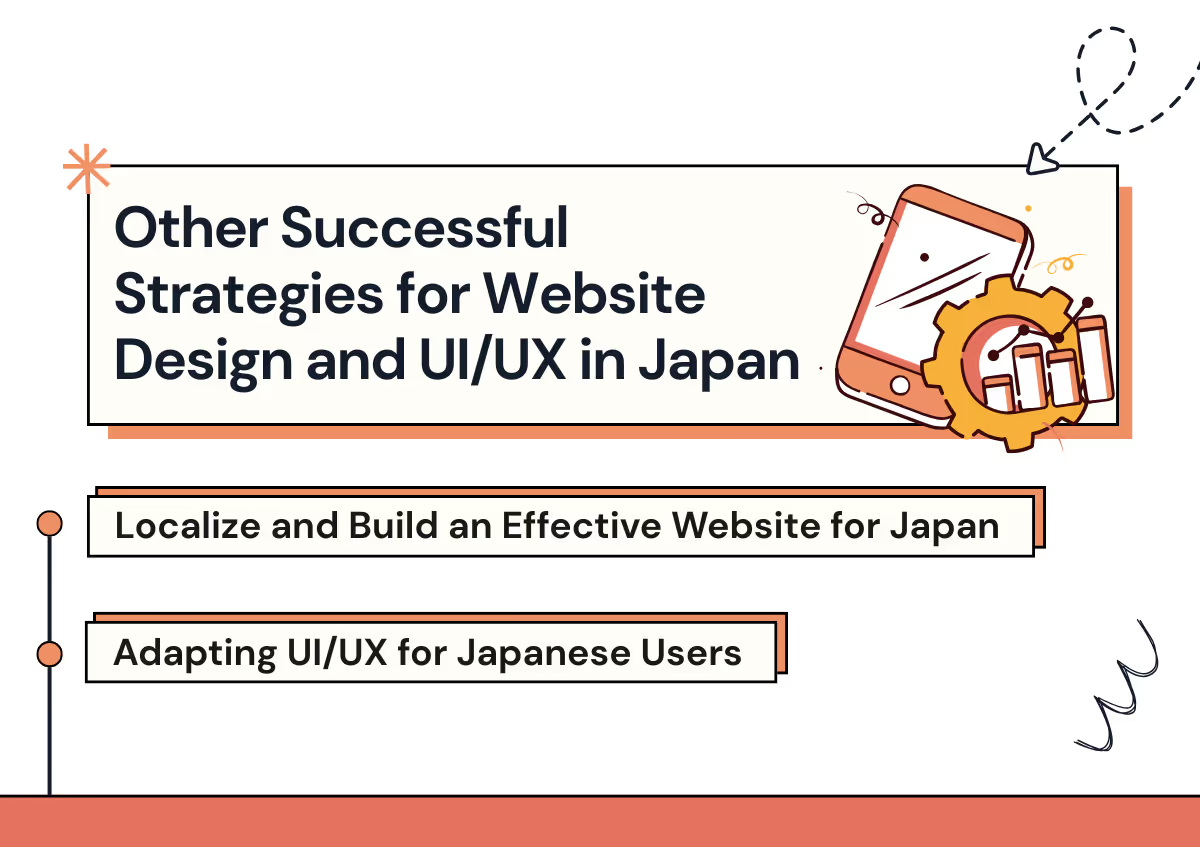
Creating an effective digital presence in Japan requires more than just translating content. Success comes from adapting both the visual design of the website and the user experience (UI/UX) to align with local cultural expectations, search behaviors, and user preferences.
Here, we break down the key strategies into two distinct areas:
- Website Design—how your site looks, feels, and communicates visually.
- UI/UX—how users interact with your site, make decisions, and move through the digital journey.
Localize and Build an Effective Website for Japan
Visual and Content Localization:
- Formal, Polite Language: Japanese users prefer more formal phrasing on buttons and headers. For example, replacing the casual English “Buy Now” with a more polite Japanese phrase like 「購入はこちら」 (“Purchase Here”) conveys respect and professionalism.
- Seasonal and Cultural Design Elements: In Japan, visual design often changes with the seasons (e.g., cherry blossoms for spring, fireworks for summer) or incorporates traditional motifs that create a sense of local familiarity and emotional warmth.
- Color Symbolism: Colors carry specific cultural meanings. For example:
- Red: Excitement, urgency, good fortune.
- Violet: Nobility, elegance.
- Green: Nature, freshness, peace.
Being sensitive to these cultural color associations in your design reinforces brand authenticity.
Search Engine Optimization for Visual Design:
- Japanese websites must perform well on both Yahoo! Japan and Google Japan—this affects how you write meta titles, descriptions, and even image alt text.
- Consider page speed optimization through compressed images and light design assets, as Japanese users value fast-loading pages, especially on mobile.
Adapting UI/UX for Japanese Users
- User Journey & Interaction:
- Preference for Information-Rich Interfaces: Japanese users often feel more comfortable when detailed information is available upfront. A minimalist, Western-style approach can feel lacking or incomplete in the Japanese context.
- Ensure that product pages, service descriptions, and CTAs offer thorough details, specifications, and multiple layers of explanation to build trust and confidence.
- Politeness and Formal UI Microcopy:
- The tone of voice in buttons, forms, and notifications should reflect politeness and social etiquette. For example:
- Instead of “Sign Up,” use「会員登録はこちら」(Membership Registration Here).
- Error messages and confirmations should be phrased gently, avoiding abrupt language.
- Multilingual SEO and UI Considerations:
- Keyword Localization for Japanese Search Behavior: Japanese search queries can mix kanji, katakana, hiragana, and English. For example:
- Online shopping → オンラインショッピング or 通販.
- Conduct dedicated Japanese keyword research rather than relying on translated English keywords.
- Implement hreflang tags correctly to help Google and Yahoo! display the appropriate language version, ensuring that Japanese users land on Japanese content.
- Cross-Channel UX Touchpoints:
- 일본에서는 LINE, X (구 Twitter), Instagram과 같은 인기 있는 커뮤니케이션 채널을 UI에 긴밀하게 통합하여 소셜 공유, 로그인 옵션, 고객 참여를 장려해야 합니다.
- 일본 사용자는 의사 결정 과정의 일환으로 회사 소셜 프로필을 확인하는 경우가 많습니다. 웹사이트 UX가 이러한 접점으로 사용자를 원활하게 안내하는지 확인하세요.
결론: 일본에서 웹사이트를 제대로 운영하세요
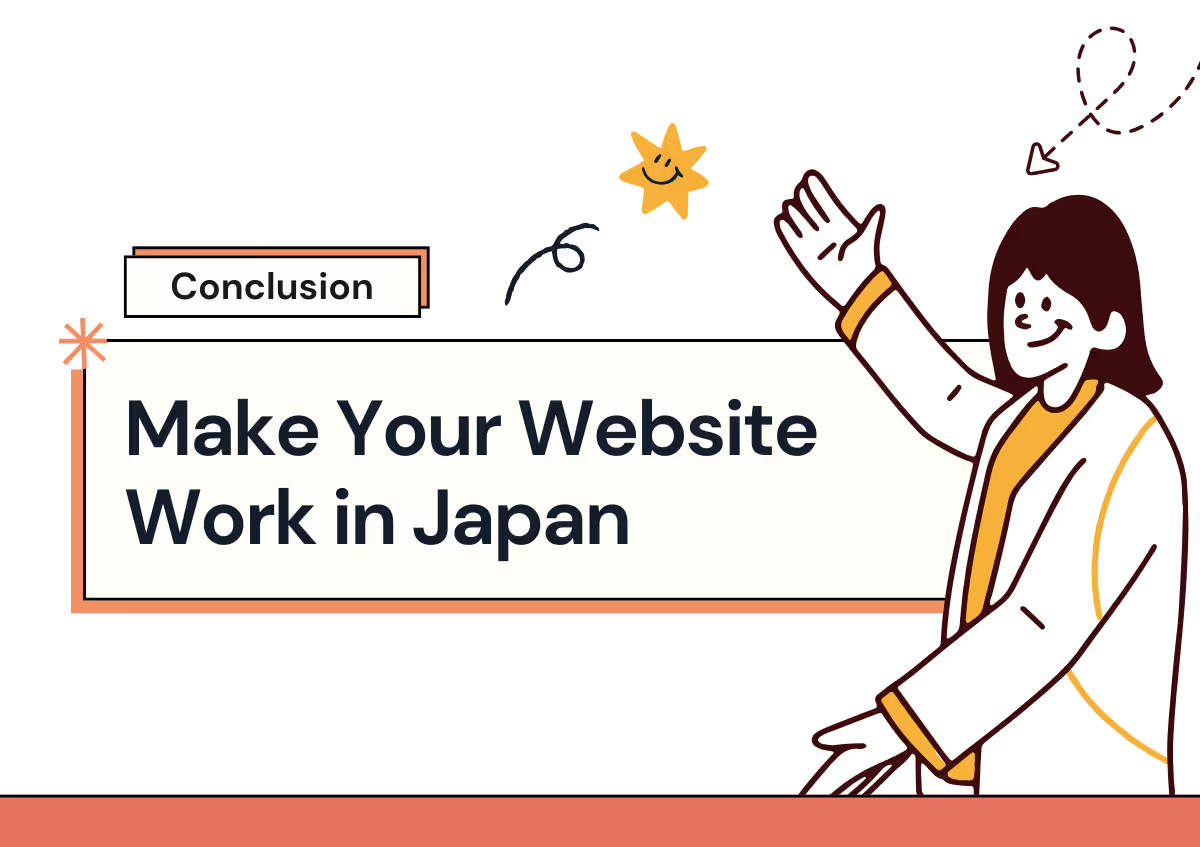
일본의 웹 사이트 디자인을 이해하면 서구의 표준과 크게 다르다는 것이 분명해집니다.서양의 디자인은 미니멀리즘과 시각적 매력을 선호하는 경우가 많지만, 일본 웹사이트는 기능성과 포괄적인 정보 전달을 우선시하는 경향이 있습니다.이러한 접근 방식은 콘텐츠의 깊이와 완벽함을 중시하는 사용자층에 적합하며, 세부 지향적인 경험에 대한 폭넓은 문화적 선호도를 반영합니다.
일본 웹 사이트 디자인의 핵심 요소에는 텍스트가 많은 레이아웃, 효율적인 공간 활용, 속도에 최적화된 이미지, 감정적 반응을 불러일으키는 생생한 색 구성표가 포함됩니다.일본 웹 디자인의 복잡성을 극복하려면 언어적 뉘앙스를 해결하고 현지 SEO 및 모바일 최적화 요구에 맞게 전략을 조정해야 합니다.일본의 디지털 환경이 발전함에 따라 웹사이트는 사용자 친숙도를 유지하는 것과 현대 트렌드에 적응하는 것 사이에서 균형을 찾아야 합니다.
일본 웹 디자인의 성공적인 전략은 현지화, 전략적 SEO, 명확하고 신뢰할 수 있는 랜딩 페이지 생성을 강조합니다.사용자 선호도를 정확히 이해하여 사이트를 구축하면 UX 기대치를 충족하고 다양한 인구 통계 전반에서 참여도를 높일 수 있습니다.
깊이, 기능 및 사용자 중심 디자인을 강조하면 기업은 일본어 UI 및 웹 사이트 디자인에 깊이 공감하는 매력적인 디지털 경험을 만들 수 있습니다.현지 에이전시와 협력하면 일본 웹 사이트 디자인의 복잡성을 헤쳐나갈 수 있는 귀중한 통찰력과 전문 지식을 얻을 수 있어 이러한 노력이 한층 강화됩니다.이러한 협업은 효과적인 참여를 보장하고 전략을 사용자의 기대에 밀접하게 맞추어 일본 시장에서 지속적인 성공을 거둘 수 있는 기반을 마련합니다.
주요 내용: 문화적으로 조화를 이루는 일본 웹사이트 제작
일본인에게 진정으로 공감할 수 있는 웹사이트를 만들 준비가 되셨나요?
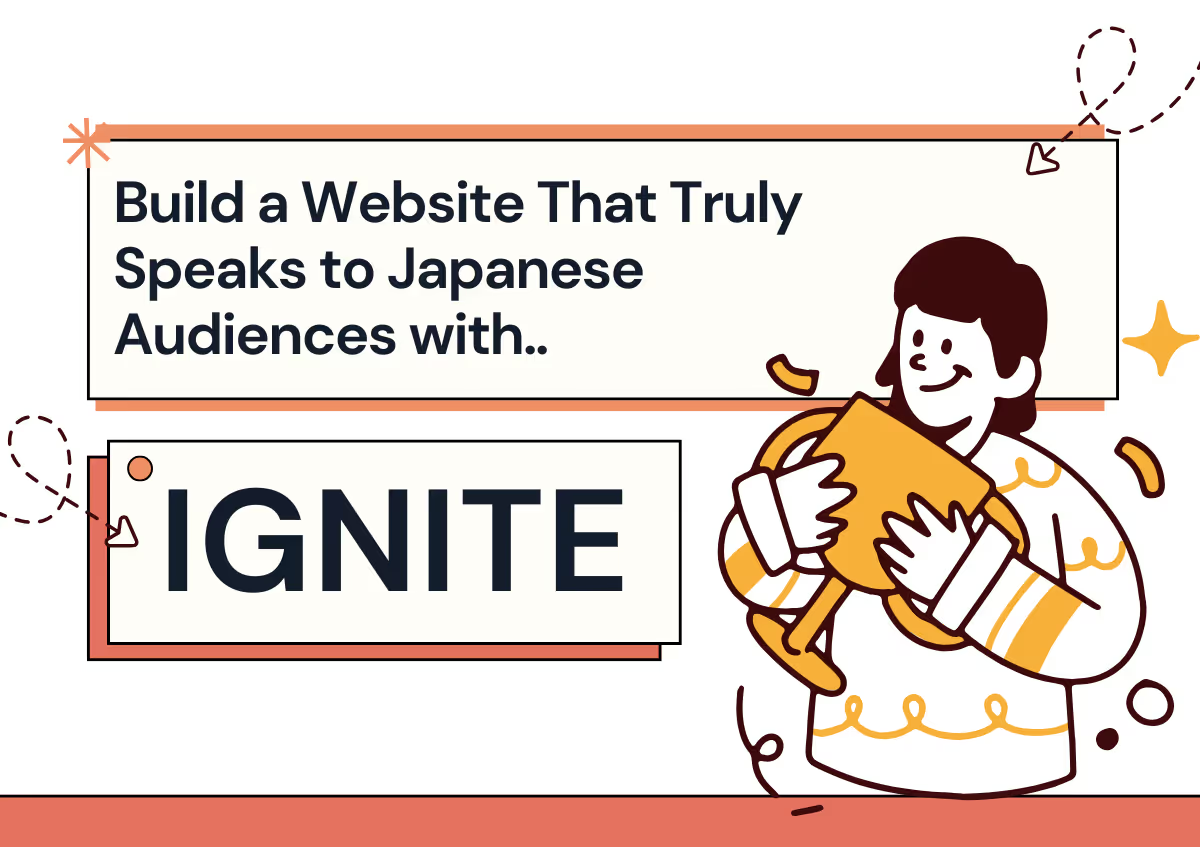
일본 웹 사이트 디자인과 UI/UX는 단순히 미학에 관한 것이 아니라 문화적 뉘앙스, 사용자 행동 및 신뢰 구축 전략에 깊이 뿌리를 두고 있습니다.브랜드가 일본 시장 진출을 진지하게 고려하고 있다면 현지화는 언어를 넘어 디지털 존재의 구조 자체에도 적용되어야 합니다.
IGNITE에서는 번역만 하는 것이 아니라 혁신합니다.
당사는 오사카에 본사를 둔 다국어 디지털 마케팅 에이전시로서 일본에 진출하는 해외 기업을 위한 웹사이트, UI/UX 흐름 및 전체 마케팅 생태계를 현지화하는 것을 전문으로 합니다.문화적으로 조율된 웹 사이트 디자인과 SEO에 최적화된 콘텐츠부터 맞춤형 랜딩 페이지 및 신뢰 구축 UX에 이르기까지 우리 팀은 일본 사용자의 공감을 얻고 전환율을 높이는 경험을 만드는 방법을 알고 있습니다.
IGNITE를 선택하는 이유는 무엇입니까?
- 현지 전문가 — 오사카에서 함께 일하는 일본 및 외국 전문가
- 맞춤형 UI/UX 전략 — 일본의 높은 기대치를 충족하도록 설계
- 종합 서비스 지원 — SEO 및 광고부터 맞춤형 개발 및 이중 언어 프로젝트 관리까지
- 결과 중심 접근 방식 — 당사는 귀사만큼 ROI를 중요하게 생각합니다.
IGNITE와 파트너 관계를 맺으세요: 일본 현지 마케팅 부서
일본 웹 디자인의 문화적, 언어적, 기술적 환경을 탐색할 수 있도록 도와드리겠습니다.
당사는 단순한 공급업체가 아니라 일본에서의 성공을 위해 최선을 다하는 현장 팀입니다.
오늘 저희에게 연락하세요 상담 일정을 잡고 일본에 대한 디지털 전략의 현지화를 시작하세요.
















